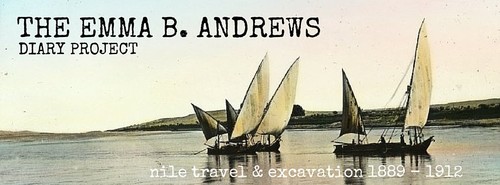Emma B. Andrews

Emma B. Andrews (1837 – 1922) was uniquely positioned to bear witness to the so-called ‘Golden Age of Egyptian Archaeology’ yet her work has, until now, been largely overlooked. Emma is best remembered for her association with the millionaire lawyer turned archaeologist/art and antiquities collector, Theodore M. Davis (1837 – 1915). She travelled to Egypt with Davis between 1889 and 1913, and kept a detailed journal of her travels along the Nile on board the dahabeah ‘Bedawin’. After several seasons as a tourist and collector, Davis was granted the coveted concession to excavate in Luxor’s Valley of the Kings. Between 1902 and 1913 he funded and oversaw the discovery of 25 significant tombs and foundation deposits. Some of the most important of these include what was probably the final resting place of the famous heretic pharaoh, Akhenaten (KV55) and the tomb of Yuya and Thuyu (KV46), parents of Queen Tiye, the richest and best preserved tomb in the Valley until the discovery of Tutankhamun’s burial site. Emma’s journals add valuable cultural and archaeological perspective to this remarkable period of modern Egyptian history.
Her life story is fascinating to modern sensibilities: she was an adventurous, intelligent and outspoken woman who carved her own path through life, defying all conventions of the time. She was the youngest daughter of a wealthy family from Columbus, OH and married lawyer Abner Andrews in 1859. Andrews was afflicted by some awful malady ‘rumored to be insanity’ and was later institutionalized. They had one child who died young. Emma first met Davis after he married her cousin Annie in 1860 and went on to become one of the most important people in his life. She eventually moved into Davis’s mansion ‘The Reef’ in Newport, RI in 1887, where she lived as his mistress, shocking polite Newport society. Davis’s wife also continued to live there until Emma had her removed in 1911. At present, there is no published work detailing her early life, her family or her relationship with Theodore Davis.
The original hand-written travel journals are now lost; what remains are two of four copies made around 1918 at the behest of Albert Lythgoe, then curator of the Egyptian Collection at the Metropolitan Museum. One of these copies, now on microfiche in the American Philosophical Society Library, has been the primary stream of source data. I have been leading a team of undergraduates in the process of transcribing the 19 volumes over the past year. The ultimate goal is to create digital editions of each volume, with associated historical and biographical analysis which is readily accessible by all, to enable in-depth study by scholars and the interested general audience.
Emma’s unpublished diary is significant on two levels. From an Egyptological standpoint, her writing provides important details about archaeological excavation during this period. Davis’s methods were not always as diligent as they should have been, and Emma’s record helps complete the archaeological and chronological picture. Davis’s extensive antiquities purchases and excavation finds, which were subsequently sent to museums in Egypt and the USA, are also detailed and certainly merit further study. Her work provides an important biographical commentary on Davis himself and the group of pioneering Egyptologists they mixed with, including William Flinders Petrie, Gaston Maspero, Arthur Weigall, Howard Carter, Percy Newberry, Edward Ayrton and many others.
On a broader level, the diaries will hold great appeal for a general readership since Emma’s writing is very engaging and its content accessible and evocative of the period. She is a literate and observant cultural commentator on turn of the century Egypt and an invaluable resource for the study of the lives of 19th century women. She paints a revealing picture of the colonial gentry and the cultural and scientific literati she and Davis mingle with, throwing her descriptions of the colorful yet poverty-stricken lives of Egyptian locals into sharp relief. Detailed analysis of these 19 volumes will afford scholars and a general audience ready access to an important historical resource for the first time.
